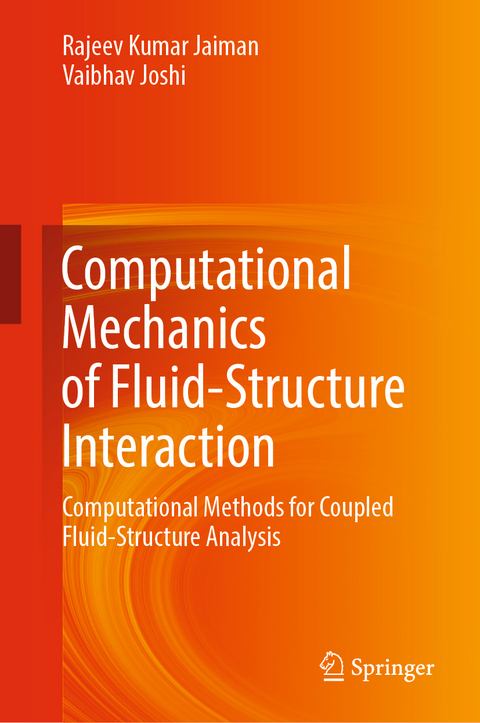
Computational Mechanics of Fluid-Structure Interaction
Springer Verlag, Singapore
978-981-16-5354-4 (ISBN)
This book also provides a comprehensive understanding of underlying unsteady physics and coupled mechanical aspects of the fluid-structure interaction from a computational point of view. Using the body-fitted and moving mesh formulations,the physical insights associated with structure-to-fluid mass ratios (i.e., added mass effects), Reynolds number, large structural deformation, free surface, and other interacting physical fields are covered. The book includes the basic tools necessary to build the concepts required for modeling such coupled fluid-structure interaction problems, thus exposing the reader to advanced topics of multiphysics and multiscale phenomena.
Dr. Rajeev K. Jaiman is currently an Associate Professor and NSERC/Seaspan Industrial Chair in the Department of Mechanical Engineering at the University of British Columbia (UBC), Vancouver, Canada. An aeronautical engineer by training, his research concentrates on high-fidelity multiphysics modeling and data-driven computing, with emphasis on large-scale computations of fluid-solid and fluid-fluid interface problems. Prior to his current appointment at UBC, he was an assistant professor in the Department of Mechanical Engineering at the National University of Singapore (NUS). Before joining NUS, he was the Director of Computational Fluid Dynamics (CFD) Development at Altair Engineering, Inc., Mountain View, California. The CFD technologies that Dr. Jaiman has developed are routinely used in marine/offshore, wind turbine, nuclear reactors, automotive and aerospace industries. Dr. Jaiman earned his first degree in Aerospace Engineering from the Indian Institute of Technology, Mumbai. He received his master's and doctorate degrees from the University of Illinois at Urbana-Champaign (UIUC). He has authored/co-authored more than 150 journals papers and conference proceedings and serves as an expert reviewer for numerous journals and books. He is currently an Associate Editor of ASME-OMAE Journal, a senior member of AIAA and members of ASME, SNAME, USACM, APS, AAM, and SIAM. Dr. Vaibhav Joshi is currently an Assistant Professor in the Department of Mechanical Engineering at Birla Institute of Technology and Science (BITS) Pilani, K. K. Birla Goa Campus, Goa, India. His research focuses on high-fidelity computational modeling of fluid-structure interaction. Prior to his current association with BITS, he was a postdoctoral research fellow in the Department of Mechanical Engineering at The University of British Columbia (UBC), Vancouver, Canada. He was in-charge of the Computational Multiphysics Laboratory at UBC and worked on developing flexible multibody fluid-structure interaction framework for bio-inspired flying vehicles. Before joining as a post-doc, he carried out his doctoral studies at the National University of Singapore (NUS) and worked as a research engineer at the Keppel-NUS Corporate Laboratory. There, he developed a computational framework to model two-phase fluid-structure interaction, motivated by the coupled offshore vessel-riser system subjected to turbulent ocean current and free surface waves. He received his Bachelor of Technology degree in Mechanical Engineering from Vellore Institute of Technology University, Vellore, India.
Chapter 1 - Introduction: A Computational Approach.- Chapter 2 - Equilibrium, Kinematics and Balance Laws.- Chapter 3 - Fluid-Structure Equations with Body-Fitted Interface.- Chapter 4 - Variational and Stabilized Finite Element Methods.- Chapter 5 - Fluid-Structure Interaction: Variational Formulation.- Chapter 6 - Quasi-Monolithic Fluid-Structure Formulation.- Chapter 7 - Partitioned Fluid-Structure Interaction Methods.- Chapter 8 - Two-Phase Fluid-Structure Interaction.- Chapter 9 - Flexible Multibody Fluid-Structure Interaction.- Chapter 10 - Turbulence Modeling in Fluid-Structure Interaction.
| Erscheinungsdatum | 06.12.2021 |
|---|---|
| Zusatzinfo | 129 Illustrations, color; 53 Illustrations, black and white; XV, 329 p. 182 illus., 129 illus. in color. |
| Verlagsort | Singapore |
| Sprache | englisch |
| Maße | 155 x 235 mm |
| Themenwelt | Mathematik / Informatik ► Mathematik ► Analysis |
| Mathematik / Informatik ► Mathematik ► Angewandte Mathematik | |
| Technik ► Maschinenbau | |
| Schlagworte | Bluff Bodies • Combined translational motions • Coupled multibody interactions • Flapping dynamics • Flapping foil • Flow-induced Vibrations • Galloping • Gap ratio effect • Inverted foil flapping • Linear Stability Analysis • Low Reynolds Number • Mean Flow in confined channel • Thin Structures • Vortex-induced Vibration • Wake-induced vibrations (WIV) |
| ISBN-10 | 981-16-5354-2 / 9811653542 |
| ISBN-13 | 978-981-16-5354-4 / 9789811653544 |
| Zustand | Neuware |
| Haben Sie eine Frage zum Produkt? |
aus dem Bereich


